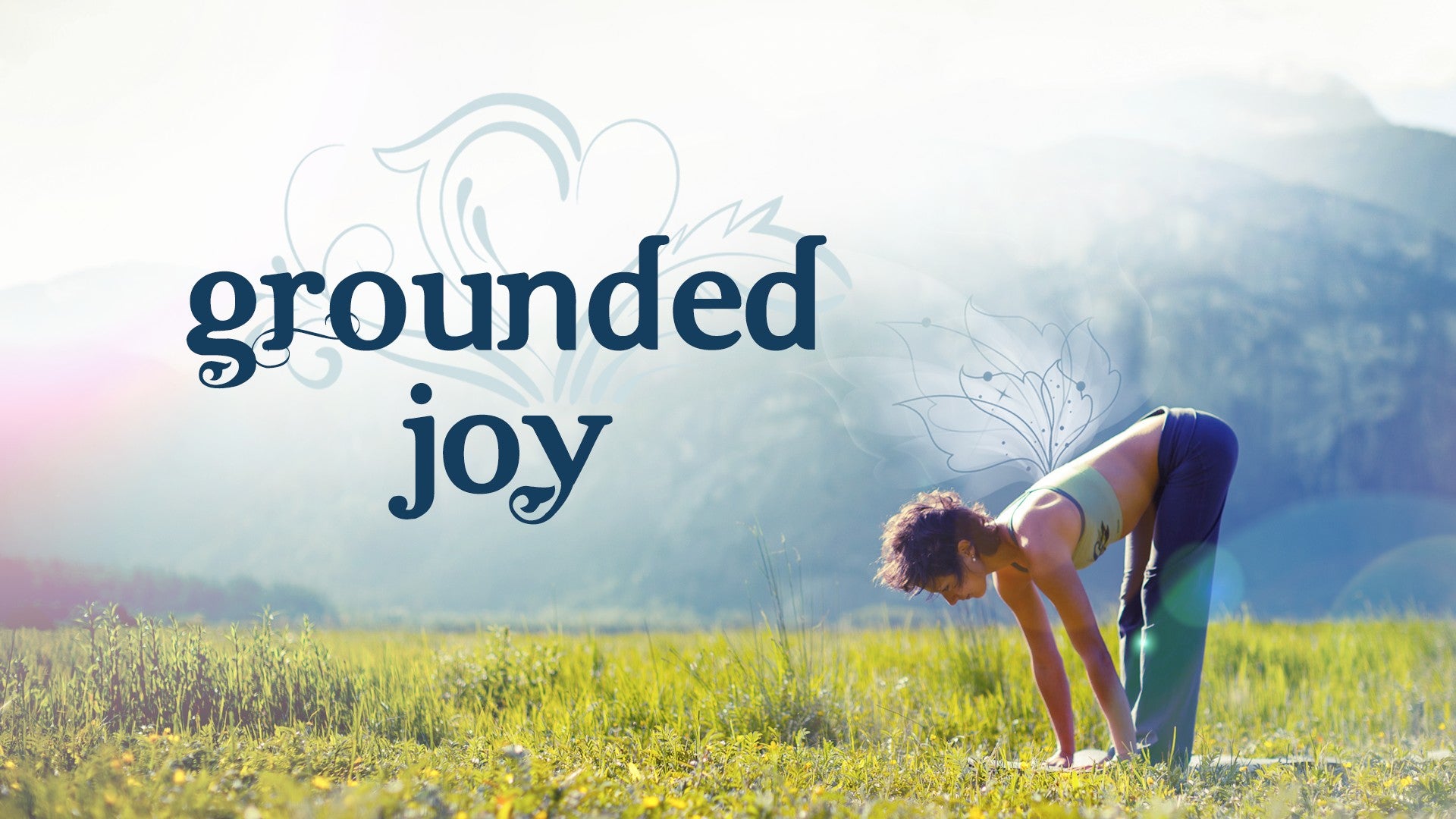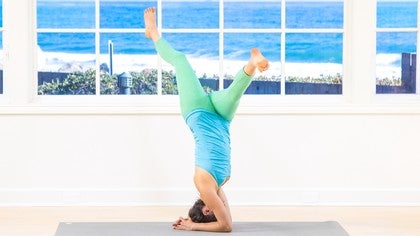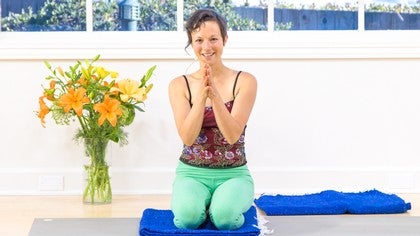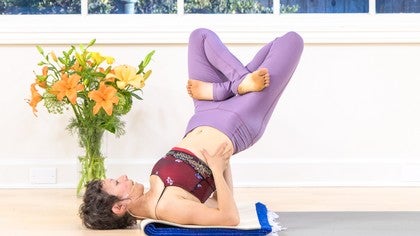Description
About This Video
Transcript
Read Full Transcript
Hi. This is the headstand practice, Sirsasana. I wanted to just say one thing before we get right into it, this is an afternoon practice, it's not recommended to be done first thing in the morning, so after the body's a little bit warm, maybe after a light lunch, then it's a good time. Just because things are a little bit more open and the fascia sort of shrink wraps at night, so it's better to do this long hold a little later in the day, or at least that's what it's meant for. Also, the shoulder stand practice is the counter pose for the headstand practice.
It's really nice to do the two of them together, that's the way they're meant to be done. So, if you do the headstand, you want to do both of them, make sure that you do this practice before you do the shoulder stand practice, do this practice, take a little rest, go right into the shoulder stand practice, and then take a Sirsasana. I mentioned in the headstand tutorial, in the Sirsasana tutorial, that I use a mirror as an alignment tool, I'm using that now. I would recommend it, it's okay if you don't use it, but it is helpful. So let's turn around on the mat, and one thing I would say before going up, is if you don't have one of these thick, nice thick mats, you have one of those little thin mats, you can actually roll the mat over like this for your platform, because sometimes it's a little bit softer, especially if you're working with a hard surface.
So, clasping the outer edges of the elbows, take the hands forwards, little bit of a loose clasp so you can feel your fingers, and root the outer pinky finger down, you can also catch the skin of the upper arms and roll out. Place your head in between your wrists. Activate the pressure down of the forearms, the press into the head, the skull and come up onto your tip toes, walk your feet in and even if you can go up two legs at a time, there's a little movement in there, there's a little piece of that movement that puts a bit of strain on your neck, so for this longer practice, come high up onto one set of toes, bring the other leg up, and come up, so even if you can come up two legs at a time, just try this with not too much change of shape, in the neck and the upper back. So Sirsasana head stand. It's nice to feel that you're bringing the legs together and if you have even like a little tiny bend in your knees, but you're reaching up through your leg bones at the same time, you have a softness, but then also a elongation up off of your skull.
Big toes and inner feet together. And leaning the inner and outer feet up. Keep the pressure on the correct place on the center of the skull. So we'll move into a few variations here, and as I said in the tutorial, if you feel anything questionable in your neck, or your upper spine or your shoulders, just come out, take a good rest and it's your choice if you want to come back in again, but make sure you come out if you feel anything that doesn't feel nice. Of course there is a little bit of strength though required to stay here.
So we're gonna keep the vertical line of the posture and without twisting at the shoulders, we're gonna rotate sort of from the lumbar spine over towards the right. So this is, Parivrrta Sirsasana. Try not to rotate your shoulders, and then we're gonna come through center, keep the vertical line so pallet to perineum, to inner feet stays the same line and rotate the lumbar spine, lower spine over to the left. There will be a little movement in your shoulders but minimize it as much as you can. Try not to poke into a back bend here, so the front rows maintain connection, and breathe.
And kneel into the center, and then allow your legs to widen, and we're gonna start to rotate the left leg forwards and the right leg behind you. And twist, try not to twist the shoulders or the neck, so the twisting is coming a little bit more in the lumbar spine, try to get your back leg a little bit back, so that you feel like your heels are somewhat level. There's a little scissoring in of the inner thighs, and then open up. And twist the right leg, twirl the right leg forwards the left leg back. So a little bit of that twist is gonna come into the upper spine, but just try to minimize it so take the outer left armpit forwards.
Little bit of a softness in your legs, but reaching out through your bones. And then come all the way back forwards, that's Eka Pada Parivrrata Sirsasana, legs come together, let's turn the right leg out in external rotation, and follow a line with the big toe, take it out and down, and have a little softness in that knee. And if you're using a mirror, you can see if you really tip your hips to try to get that leg to the floor so, keep your pubic bone lifted, and your sip bones fairly level. And then, with that feeling of up through your pubic bone, you'll have a little bit of a curve in your lower back, but you minimize it to stay upright. And bring it back up, Parsva Eka Pada Sirsasana, so left leg out to the side, and keep the l, really strong focus through this practice so, this is a very masculine posture, it's the king of the Asanas, it's called Sirsasana, the king of the Asanas.
Shoulder stand is much more feminine. So, line your sip bones, feel that the inner groins are actually kind of coming together, even though there is a feeling of opening them, so there is a little of that scissoring in. And heel come up, so just plain old Eka Pada, one legged Sirsasana, right leg comes straight down. And our left leg can go a little bit back behind you, just to sort of counter balance. And you don't have to take it all the way down to the floor, like you could, but that changes the shape of your back maybe.
Just working with the legs, pubic bone up. Let's switch. And breathe. I feel like this posture has those masculine energies of, like a protective energy for your body, so that you're being kind to your neck and shoulders, and also this laser like focus that it takes to be up like this for a long time, or a relatively long time. Inhale a couple the way up.
So open up your legs, and we're gonna do right lotus first, so if your have a lotus practice here, helicopter the legs, but keep a stillness through your torso, half bound lotus with your right leg, snuggle it down towards the hip crease, move the inner thigh into more length, so you can take the left heel in front. Padmasana in Sirsasana. And then, Parivrrta Padmasana in Sirsasana, a little twist but trying to keep the vertical line as much as you can, you'll have a little more back bend here, into the center, over to the other side. Try not to twist the shoulders, in these twisting ones, maintain the outer armpits rolling forwards. Into the center.
And I don't really love this one, ha ha, it's a, Pindasana, like this coming down, I don't come down that low, because if you come down lower, you'll feel what happens in your neck, so just come down a little bit, and then come up. Some people come down, really take the thighs to the chest. Unwind, and we're gonna do the other lotus, so release your legs, left leg, snuggle. So the snuggling is like a, in and out, scissoring kind of side to side movement, left inner thigh lengthens so that you have more space to bring the ankle in front. And then we lengthen out through the inner groins.
Padmasana in Sirsasana, maintain that pressure through your forearms, and then, a little twist to the right. Feel if there is that asymmetry going on in your shoulders, like it's okay if there's a little bit, but as long you can maintain an evenness of tone to the left, and kind of a spaciousness around the joints, so there's strength going on, there's maybe even fatigue in the musculature, but there's always a spaciousness in the joints, into the center, any amount. Coming down. Then coming up, unwinding. So Repress Retepado Tenesana in Sirsasana, just widen the legs.
Pointing the inner seam of your pants upwards, it's different to actually roll the hamstrings up. A different feeling, so you can try that. Baddha Konasana in Sirsasana, soles of the feet together. Maintain length in your lower back. Vadrasana, inner legs together.
And you can, Parivrrta it, twist it to one side, being really mindful of your shoulders and this one's really nice to open up the groin, so there's, a nice lengthening through the fronts of the hips. And your feet together, it's like you have a little mermaid tail. And to the center, back up. And we're gonna come down, and if you want to be really gentle here, one leg at a time I would recommend. That's what I'm gonna do, just to maintain that feeling of spaciousness around the cervical spine.
And then I'm gonna roll right into a child's pose without lifting the head, so roll right onto the hairline. Slide the hands back and just roll a little side to side on your forehead. Close your eyes and notice all of that pooling of blood that's in your upper body now, nourishing and irrigating your senses and your brain, and your master glands. Checking in for any feelings, of compression, on the neck spine. Notice what sensations wash over you here.
And roll up when you're ready. So I'm gonna do the counter pose for this practice is the shoulder stand practice, so I'm gonna do the Sirvasana at the end of that practice. If you're only doing this practice on it's own, you can take a Sirvasana now. See you in the shoulder stand practice. Namaste.






You need to be a subscriber to post a comment.
Please Log In or Create an Account to start your free trial.